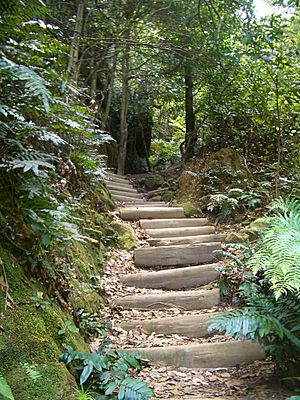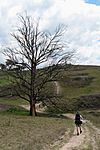Blue Mountains walking tracks facts for kids
Quick facts for kids Blue Mountains walking tracks |
|
|---|---|

Steps in the Six Foot Track, pictured in 2007.
|
|
| Location | Blue Mountains National Park, City of Blue Mountains, New South Wales, Australia |
| Built | 1880– |
| Owner | NSW Office of Environment and Heritage |
| Official name: Blue Mountains Walking tracks | |
| Type | State heritage (complex / group) |
| Designated | 2 April 1999 |
| Reference no. | 980 |
| Type | Trail/Track |
| Category | Transport - Land |
| Lua error in Module:Location_map at line 420: attempt to index field 'wikibase' (a nil value). | |
The Blue Mountains walking tracks are a special network of paths, picnic spots, and rest areas. They are found in the beautiful Blue Mountains National Park in New South Wales, Australia. These tracks have been around since the 1880s. They are owned by the NSW Office of Environment and Heritage. These tracks are so important that they were added to the New South Wales State Heritage Register in 1999.
Contents
History of the Blue Mountains Tracks
The Blue Mountains National Park is a very popular place to visit in New South Wales. In 2014, it was the most visited national park in the state. About 4.2 million people visited the park that year. This made it even more popular than Royal National Park. People love to explore the many walking tracks here.
Exploring the Blue Mountains Walking Tracks
Many different walking tracks are part of this special heritage area. Each track has its own unique features and beauty. The table below lists some of these important tracks. It also shows where they are located.
| Tab No. | SHI No. | Item name | Location | Image |
|---|---|---|---|---|
| 1 | 3900010 | Causeway to Red Hands Cave | Glenbrook | |
| 2 | 3900033 | Grotto Tracks | Springwood | |
| 3 | 3900043 | Florabella Pass | Warrimoo and Blaxland | |
| 4 | 3900048 | Kings Cave Track | Linden | |
| 5 | 3900088 | Princes Rock Track | Wentworth Falls | |
| 6 | 3900099 | Den Fenella Track | Wentworth Falls | |
| 7 | 3900112 | Jamison Creek Corridor/Darwins Walk | Wentworth Falls | |
| 8 | 3900115 | Valley of the Waters Track | Wentworth Falls | |
| 9 | 3900120 | National Pass | Wentworth Falls | |
| 10 | 3900138 | Federal Pass | Katoomba/Leura |  |
| 11 | 3900140 | Giant Stairway | Katoomba | |
| 12 | 3900152 | Orphan Rock Track [closed] | Katoomba | |
| 13 | 3900153 | Prince Henry Cliff Walk | Katoomba/Leura | |
| 14 | 3900157 | Track from Lilianfels Park to Lady Darleys Lookout | Katoomba | |
| 15 | 3900197 | O'Sullivan's Road | Katoomba | |
| 16 | 3900215 | Grand Canyon Track | Blackheath | |
| 17 | 3900217 | Point Pilcher Track | Blackheath/Medlow Bath | |
| 18 | 3900223 | Perrys Lookdown to Blue Gum Forest | Blackheath |  |
| 19 | 3900232 | Engineers Track | Grose Valley (Darling Causeway to Nepean River) | |
| 20 | 3900241 | Bruce's Walk | Lawson to Mount Victoria | |
| 21 | 3900247 | Six Foot Track | Katoomba to Jenolan Caves |  |
| 22 | 3900272 | Lawsons Long Alley | Mount Victoria | |
| 23 | 3900273 | Lockyers Road | Mount Victoria | |
| 24 | 3900276 | Berghofers Pass | Mount Victoria | |
| 25 | 3900277 | Section of Bells Line of Road | Mount Tomah | |
| 26 | 3900282 | Kanangra Walls Cattle Track | Oberon | |
| 27 | 3900320 | Megalong Valley Aboriginal Routes | Katoomba | |
| 28 | 3900321 | Mount Victoria Escarpment Complex | Mount Victoria | |
| 29 | 3900328 | Mount York Roads Complex | Mount Victoria | |
| 30 | 3900329 | Wentworth Falls Complex | Wentworth Falls | |
| 31 | 3900330 | Cox's Road Complex | Faulconbridge to Mount York | |
| 32 | 3900331 | Parkes Garden Tracks Complex | Faulconbridge | |
| 33 | 3900332 | Wolgan Railway Complex | Newnes railway which is now a rail trail | |
| 34 | 3900333 | Upper Grose Valley Aboriginal Passes - Complex | Blackheath | |
| 35 | 3900334 | Track to Base of Govetts Leap - Complex | Blackheath | |
| 36 | 3900335 | Tracks to Ruined Castle - Complex | Katoomba | |
| 37 | 3900336 | Grose Valley Cliff Edge - Complex | Blackheath |
Why These Tracks Are So Special
The Blue Mountains walking tracks are considered very important to Australia's history and culture. This is why they are "heritage-listed". They are a great example of how people have enjoyed nature for a long time.
A Mix of Nature and Human Design
These tracks show how people have worked with nature. They were designed to blend in with the beautiful landscape. Early track builders used clever ways to create paths. They also built features like shelter sheds, wells, and railings. These features were made from the 1870s all the way to the 1960s. They show how building methods and ideas about nature have changed over time.
Learning from the Past
The way these tracks were built can still teach us today. For example, the early builders found smart ways to handle water and use stone. Their solutions to design problems are still valuable for research. Many of the man-made parts of the tracks are also very beautiful. They are more than just useful; they add to the scenery.
Connecting People to Nature
The Blue Mountains tracks have helped many Australians connect with nature. They are close to Sydney, and it was easy to get there by train. This made it simple for city people to visit the natural environment. The tracks played a big part in the growth of tourism in the Blue Mountains. People came to walk and enjoy the outdoors.
Inspiring Conservation
These tracks have also helped people care more about nature. As more people walked the paths, they learned to appreciate the environment. This helped grow the idea of protecting natural places. Many walkers have written about their experiences. They took photos and shared their feelings about the tracks. These records show how Australians' relationship with nature has changed over more than 100 years.
A Living History
Even today, people can walk these same historic tracks. They can use the same structures that people used long ago. This helps them feel a connection to the past. It's like stepping back in time while enjoying the beauty of the Blue Mountains. The Blue Mountains walking tracks were officially added to the New South Wales State Heritage Register on April 2, 1999.

